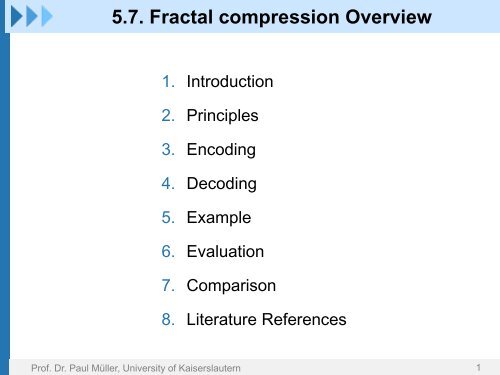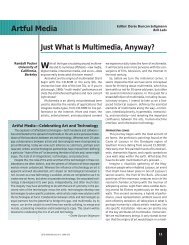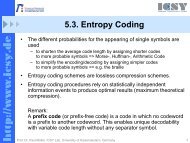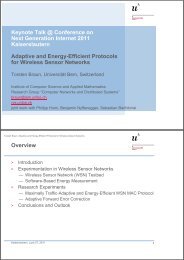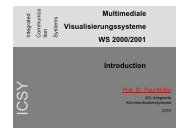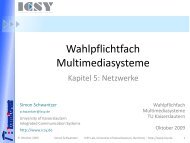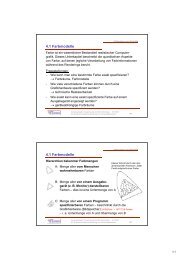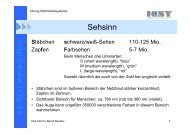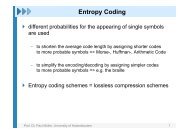5.7. Fractal compression Overview - ICSY
5.7. Fractal compression Overview - ICSY
5.7. Fractal compression Overview - ICSY
You also want an ePaper? Increase the reach of your titles
YUMPU automatically turns print PDFs into web optimized ePapers that Google loves.
<strong>5.7.</strong> <strong>Fractal</strong> <strong>compression</strong> <strong>Overview</strong><br />
1. Introduction<br />
2. Principles<br />
3. Encoding<br />
4. Decoding<br />
5. Example<br />
6. Evaluation<br />
7. Comparison<br />
8. Literature References<br />
Prof. Dr. Paul Müller, University of Kaiserslautern<br />
1
Introduction (1) - General<br />
Use of self-similarities between<br />
picture ranges<br />
Geometrical and brightness<br />
modification to describe a range<br />
Perception and efficient coding<br />
of self-similarities (↔ redundant<br />
information) through fractal<br />
transformations<br />
No pixel values are stored, only<br />
transformation parameters<br />
Prof. Dr. Paul Müller, University of Kaiserslautern<br />
2
Introduction (2) - General<br />
<br />
Concept is based on the Fixpoint Theorem from Banach and IFS (Iterated<br />
Function Systems)<br />
<br />
<br />
<br />
<br />
Reconstruction is independent of original resolution, (e.g. enabling a zoom<br />
function without negative side effects such as interpolation)<br />
Lossy and extremely asymmetric <strong>compression</strong> method<br />
Developed by Michael F. Barnsley in 80´s at the Georgia Institute of Technology<br />
Barnsley"s company "Iterated Systems" owns the licenses for full-automatic fractal<br />
<strong>compression</strong><br />
Prof. Dr. Paul Müller, University of Kaiserslautern<br />
3
Introduction (3) - MRCM<br />
The Multi Reduction Copy Machine<br />
<br />
<br />
<br />
Optional number of lenses<br />
Optional rate of diminution<br />
Optional arrangement of copies<br />
Example: Sierpinsky Triangle<br />
3 Lenses<br />
Diminution to 25%<br />
Pyramidal arrangement<br />
The geometric transformation of the MRCM can be expressed<br />
by six parameters:<br />
The affine coefficients a,b,c,d cause a mirroring, rotation and<br />
diminution. The offset T (e,f) describes the geometric<br />
displacement.<br />
Prof. Dr. Paul Müller, University of Kaiserslautern<br />
4
Introduction (4) - MRCM Samples<br />
after 0 iteration after 1 iteration after 2 iterations<br />
after 3 iterations after 4 iterations after 5 iterations<br />
Prof. Dr. Paul Müller, University of Kaiserslautern<br />
5
Introduction (5) - The "inverse" problem<br />
Iteration converges to Sierpinsky Triangle ("Attractor")<br />
Optional size / resolution<br />
Independent of input image<br />
Compression – "inverse" problem<br />
extension of MRCM necessary for efficient coding<br />
Prof. Dr. Paul Müller, University of Kaiserslautern<br />
6
Principles (1) - Partitions<br />
2 Partitions<br />
<br />
<br />
Range blocks R i (often uniform<br />
size, non-overlapping)<br />
Domain blocks D i (optional size,<br />
overlapping)<br />
surjective function D i → R i<br />
Idea: Manipulation of<br />
(relatively) big domain blocks<br />
to describe range blocks<br />
Task: Finding the best<br />
matching domain-block for<br />
each range block<br />
Matching criteria essential for<br />
complexity<br />
Prof. Dr. Paul Müller, University of Kaiserslautern<br />
7
Principles (2a) - Transformations<br />
Geometric transformation of a domain block i (see MRCM):<br />
Transformation matrix (a,b,c,d)<br />
Usually operations are applied to rectangular areas (often<br />
quadratic areas) are used. Therefore the geometric<br />
transformations for a,b,c,d are limited to the following 8<br />
operations:<br />
Prof. Dr. Paul Müller, University of Kaiserslautern<br />
8
Principles (2b) - Transformations<br />
The luminance transformation tolerates a variance and change<br />
of the leading sign of the contrast, also the mean value of the<br />
brightness could be changed. To achieve a higher similarity<br />
between domain and range blocks, the brightness and variance<br />
are corrected after the geometric adaption. This can be done<br />
using the method of the smallest quadrates, by minimizing the<br />
following expression:<br />
whereby d(x,y) is the domain block and r(x,y) is the range<br />
block.<br />
From the geometric and luminance transformation follows the<br />
resulting transformation:<br />
Prof. Dr. Paul Müller, University of Kaiserslautern<br />
9
Principles (3) - Fixpoint Theorem<br />
Idea based on the Fixpoint Theorem from Banach also<br />
known as "Contraction Mapping Theorem" (CMT)<br />
Quotes that:<br />
<br />
<br />
any contractive auto-mapping function within a metrical space<br />
contains a fix point<br />
Iterative application of function converges to fix point<br />
Original picture is defined a "Banchachscher fix point" and<br />
transformation needs to fulfill the CMT accomplishments<br />
to ensure reconstruction<br />
Quality of result after each iteration is usually measured<br />
by the "Collage Theorem"<br />
Prof. Dr. Paul Müller, University of Kaiserslautern<br />
10
Principles (4) - Metrics<br />
<strong>Fractal</strong> Compression produces a certain error since<br />
perfect reconstruction is (usually) not possible<br />
Error can be kept on an appropriate level by any function<br />
accomplishing metrical properties (e.g. accumulation of<br />
single pixel differences)<br />
Finite input (as pictures) is commonly based on the L2<br />
metric<br />
Based on the applied metric, the so called "Peak Signal to<br />
Noise Ratio" (PSNR), describes the difference between<br />
two picture (-areas)<br />
Prof. Dr. Paul Müller, University of Kaiserslautern<br />
11
Principles (5) - PSNR<br />
Peak Signal to Noise Ratio<br />
<br />
Measured in dB<br />
The higher the value, the smaller the perceivable<br />
difference<br />
For a value ≥ 40 dB, no difference can be perceived<br />
between copy and original anymore<br />
Prof. Dr. Paul Müller, University of Kaiserslautern<br />
12
Principles (6) - Collage Theorem<br />
<strong>Fractal</strong> Compression is based on sub-optimal parameters →<br />
error occurrence<br />
Collage Theorem defines an upper error limit<br />
Basically a conclusion from the Contraction Mapping Theorem:<br />
The distance |x-w(x)| is also called "Collage Error"<br />
Task: To apply a contraction W : F → F that minimizes the<br />
distance |x-x f |<br />
Minimization is achieved by minimizing the error of each partial<br />
transformation (also called Collage Coding)<br />
Prof. Dr. Paul Müller, University of Kaiserslautern<br />
13
Encoding (1) - Range block Partition<br />
Basically 3 different methods are used for the range block<br />
partition<br />
Uniform Partition:<br />
<br />
<br />
Same size for each block (e.g. 4x4, 8x8 pixel)<br />
Simple but inefficient<br />
Quadtree Partition:<br />
<br />
<br />
Based on squares with adaptive sizes to information content<br />
relatively simple and relatively efficient<br />
HV- Partition:<br />
<br />
<br />
Based on quadrangles with adaptive sizes to information content<br />
Advanced but efficient<br />
Prof. Dr. Paul Müller, University of Kaiserslautern<br />
14
Encoding (2) - Range block partition example<br />
Prof. Dr. Paul Müller, University of Kaiserslautern<br />
15
Encoding (3) - Domain block partition<br />
By defining a set of range blocks the choice of potential<br />
domain blocks becomes reduced<br />
Compromise between number and size has to be taken<br />
Too many and/or too small domain blocks:<br />
<br />
<br />
Very good results<br />
Poor performance<br />
Too few and/or too big domain blocks:<br />
<br />
<br />
Poor results<br />
Great performance<br />
Optimal block matching strategy is not reasonable (see<br />
example)<br />
Prof. Dr. Paul Müller, University of Kaiserslautern<br />
16
Encoding (4) - Codebook generation<br />
Assignment of domain to range blocks is also known as<br />
"Codebook Generation" (thus, the assignment table itself<br />
is called "Codebook")<br />
Pixels are vertically and horizontally scanned<br />
Legal operations are applied on domain blocks and best<br />
match is written in codebook<br />
Prof. Dr. Paul Müller, University of Kaiserslautern<br />
17
Decoding (1) - iterative buffer strategy<br />
Decoding requires a small part of the coding complexity only<br />
Decoding is based on two scalable buffers A and B<br />
The following 5 steps are executed until the implemented loop<br />
condition (specifying a quality parameter) is fulfilled:<br />
<br />
<br />
<br />
<br />
<br />
Step 1: block boarders of domain- and range blocks are read and<br />
written into buffer (starting with Buffer A)<br />
Step 2: Resolution reduction of domain blocks to size of range<br />
blocks, eventually geometric adaptation<br />
Step 3: Multiplication of reduced domain blocks with contrast and<br />
addition of brightness value on each pixel of the reduced range<br />
blocks<br />
Step 4: Saving of the resulting picture in the opposite buffer<br />
Step 5: if differences between buffer A and B are beyond the<br />
specified tolerance go back to Step 1 using the buffer with the<br />
resulting picture.<br />
Prof. Dr. Paul Müller, University of Kaiserslautern<br />
18
Decoding (2) - Alternative Strategies<br />
Alternative decoding modes are e.g.:<br />
<br />
<br />
<br />
Thumbnails: provides smaller preview pictures<br />
Pyramidal Arrangement: resolution is doubled each iteration<br />
(reasonable and requires less space)<br />
Best Time Algorithms: optimize the total decoding time for<br />
reconstruction of complete picture<br />
Remark:<br />
Maximum quality of the reconstructed picture can only be<br />
slightly influenced by the choice of the decoding method.<br />
The quality essentially depends on the complexity of the<br />
algorithms that search appropriate transformation<br />
parameters.<br />
Prof. Dr. Paul Müller, University of Kaiserslautern<br />
19
Example (1) - Block coding<br />
Picture: Lenna, 256x256 pixel, 256 grayscales<br />
(→ 512x512 = 262.122 byte)<br />
Partitions:<br />
Range Blocks - uniform partition (8x8 pixel = 1.024)<br />
Domain blocks - uniform, overlapping (16x16 pixel =<br />
58.081, optimal but extremely complex choice)<br />
Transformations:<br />
Rotations: 0°,90°,180°,270°<br />
Mirroring<br />
Diminution factor = 25% (fixed by partition choices)<br />
Brightness transformation<br />
Prof. Dr. Paul Müller, University of Kaiserslautern<br />
20
Example (2) - Complexity and size<br />
Complexity<br />
<br />
<br />
Geometrical Adaptation:<br />
• # range blocks (1.024) x # of domain blocks (58.081) x # geom.<br />
transformations (8)<br />
= 475.799.552 operations<br />
Brightness- and contrast adaptation:<br />
• # range blocks (1.024) x # domain blocks (58.081)<br />
= 59.474.944 operations<br />
Size<br />
# transformations (1.024) x<br />
[ # bits for source coding (16) +<br />
# bits for geometrical transformations (3) +<br />
# bits for Brightness- and Contrast adaptation (12) ]<br />
= 3.986 bytes<br />
+ control data<br />
→ total ~ 8.192 byte<br />
→ Compression rate of 16,5<br />
Prof. Dr. Paul Müller, University of Kaiserslautern<br />
21
Example (3) - Sample pictures<br />
Original (0 iteration)<br />
after 1st iteration<br />
after 2nd iteration<br />
after 10th iteration<br />
Prof. Dr. Paul Müller, University of Kaiserslautern<br />
22
Evaluation (1) - General<br />
Powerful alternative to block orientated methods such as<br />
e.g. DCT<br />
Remarkable <strong>compression</strong> rates<br />
Excellent zoom function / presentation of natural photos<br />
and sharp edges<br />
Negative effect at too high <strong>compression</strong> rates (see sample<br />
pictures)<br />
Complexity still too high to be considered a reasonable<br />
alternative to Wavelets (even though special HW support<br />
is applied)<br />
Popularity and use furthermore reduced by license fees<br />
Prof. Dr. Paul Müller, University of Kaiserslautern<br />
23
Evaluation (2) - Performance<br />
Performance and complexity mainly depend on implemented<br />
search strategies<br />
The following three statements might give an impression of the<br />
present situation and the development of the performance:<br />
1988 – Barnsley about encoding a "complex" photo:<br />
Complexity of about 100 hours on 2 Workstations<br />
1997 – Diploma Thesis: <strong>Fractal</strong> Image <strong>compression</strong> / adaptive<br />
algorithms<br />
Complexity of only the range block partition of a 512x 512 BW<br />
photo still varies between 1,5 – 57 minutes<br />
2002 – Class: Digital Image Processing (University of<br />
Dortmund, Germany)<br />
Complexity of a "regular" photo still ranges from 50 – 147<br />
seconds<br />
Prof. Dr. Paul Müller, University of Kaiserslautern<br />
24
Evaluation (3) - Fields of application<br />
<strong>Fractal</strong> <strong>compression</strong> is mainly used for picture and video<br />
files<br />
Nevertheless, good results can also be achieved for audio<br />
files<br />
Application only seems reasonable when consumer/user<br />
does not get involved with coding complexity<br />
2 commercial examples:<br />
<br />
<br />
Star Trek II (1982): Background landscapes were created by IFS<br />
Encarta (1992): fractal encoded images of a multimedia<br />
encyclopedia from Microsoft<br />
Hybrid coding methods gain interest (e.g. the additional<br />
use of DCT to obtain a scalable overall quality level for<br />
any picture)<br />
Prof. Dr. Paul Müller, University of Kaiserslautern<br />
25
Comparison (1) - Experiment<br />
4 <strong>compression</strong> methods have been compared based on<br />
their <strong>compression</strong> rate and the corresponding PSNR<br />
Experiment has been conducted by Y. Fisher, D. Rogovin,<br />
and T. P. Shen (motive: Lenna with 512x512 pixels)<br />
Compared methods<br />
<br />
<br />
<br />
<br />
Wavelets<br />
JPG (based on DCT)<br />
<strong>Fractal</strong> (HV partition)<br />
<strong>Fractal</strong> (Quadtree partition)<br />
Prof. Dr. Paul Müller, University of Kaiserslautern<br />
26
Comparison (2) - Evaluation<br />
Compression Rates 1 – 5:<br />
<br />
<br />
Best results obtained through wavelet transformation<br />
Application of the complex fractal <strong>compression</strong> must be<br />
reasonably questioned for efficiency reasons<br />
Compression Rates 5 – 30:<br />
<br />
All methods provide similar good results (excluding quadtree)<br />
Compression Rates 30+:<br />
<br />
<br />
Cleary demonstrates the limited use of DCT whose resulting<br />
quality strongly decreases<br />
Resulting quality of all 3 further methods decreases proportionally<br />
to increasing <strong>compression</strong> rate<br />
Generally the fractal <strong>compression</strong> provides the best<br />
results at <strong>compression</strong> rates from 10-30<br />
Prof. Dr. Paul Müller, University of Kaiserslautern<br />
27
Comparison (3) - Samples 1<br />
DCT (1:10) <strong>Fractal</strong> (1:10) Wavelet (1:10)<br />
Prof. Dr. Paul Müller, University of Kaiserslautern<br />
28
Comparison (4) - Samples 2<br />
DCT (1:25) <strong>Fractal</strong> (1:25) Wavelet (1:25)<br />
Prof. Dr. Paul Müller, University of Kaiserslautern<br />
29
Comparison (5) - Samples 3<br />
DCT (1:50) <strong>Fractal</strong> (1:50) Wavelet (1:50)<br />
Prof. Dr. Paul Müller, University of Kaiserslautern<br />
30
Comparison (6) - Samples 4<br />
DCT (1:100) <strong>Fractal</strong> (1:100) Wavelet (1:100)<br />
Prof. Dr. Paul Müller, University of Kaiserslautern<br />
31
Literature References<br />
Literature<br />
Digitale Bildcodierung, Jens-Rainer Ohm - Springer ISBN: 3-540-<br />
58579-6<br />
<br />
Demo<br />
<br />
Videokompressionsverfahren im Vergleich, Tosten Milde –dpunkt,<br />
ISBN:3-920993-23-3<br />
http://www.eurecom.fr/~image/DEMOS/FRACTAL/<br />
Comparison of image <strong>compression</strong> methods<br />
<br />
http://archiv.tuchemnitz.de/pub/1998/0010/data/vortrag/dth/pictures.html<br />
Prof. Dr. Paul Müller, University of Kaiserslautern<br />
32


